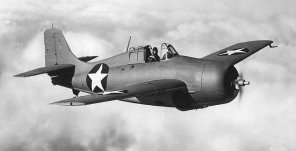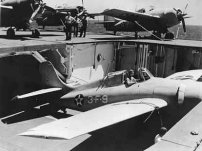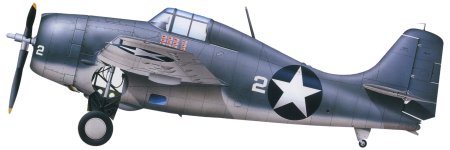
Grumman F4F Wildcat
In the 1930s the US Navy mistakenly chose the Brewster Buffalo over the Grumman F4F Wildcat. By the 1941 Pearl Harbor attack, however, the decision was reversed: the Wildcat replaced Navy biplane fighters and battled Japanese Zeros in the Pacific. A far better fighter than the Brewster, the Wildcat did not meet the standards of the Japanese Zero but it contributed mightily to the American war effort. Lieutenant Edward 'Butch' O'Hare, flying an F4F, shot down five Japanese bombers in five minutes to become the first US Navy ace.
The Wildcat was sturdy and very manoeuvrable. It was not the easiest aircraft to fly out but, once mastered, was incredibly responsive. Most Wildcats were manufactured by General Motors as the FM-2. Some went to Britain's Royal Navy, which called it the MArtlet.
This portly, mid winged fighter made a vital contribution: outnumbered and outgunned, it held the line until the most successful naval fighter in history, the Grumman F6F Hellcat, became available to turn the tide of the Pacific War.
Wildcat squadrons used by the American Marines and Navy made their stand against Japan's superior Mitsubishi A6M Zero. While the Zero held the advantage in performance, the Wildcat achieved its greatness in part due to the exceptional men who flew it. As Foster Hailey of the New York Times said in 1943: 'The Grumman Wildcat, it is no exaggeration to say, did more than single instruments of war to save the day in the Pacific.'
 |
 |
 |
| With its holding wings and catapult gear the Wildcat was a dedicated carrier fighter both with the US Navy and the Royal Navy. However, the F4F also saw action from land bases. |
The American F4F was exported to the Royal Navy for operation aboard its carrier, and was for a while designated the Grumman Martlet until the service returned to the name Wildcat. |
Until it started being replaced by the Hellcat from 1943, the Wildcat was the US Navy's most important fighter. This example carries the markings of fighter squadron VF-41. |
|
Grumman F4F Wildcat (Technical Specification) |
| Role |
Single-seat carrier based fighter |
| Manufacturer |
Grumman |
| Maximum Speed |
512 kmh (317 mph) |
| Maximum Range |
1,239 km (768 miles) |
| Ceiling |
12,010 meters (39,400 feet) |
Weight
Empty
Maximum Takeoff |
2,612 kg (5,746 lbs)
3,607 kg (7,935 lbs) |
Dimensions
Wingspan
Length
Height
Wing Area |
11.60 meters (38 ft)
8.50 meters (28 ft)
3.60 meters (12 ft)
24.15 square meters (260 sq ft) |
| Engines |
One Wright R-1830-36 Cyclone radial piston engine which provides 895-kW (1,200 hp) |
| Armament |
Six fixed 12.7 mm (0.50 cal) Browning air-cooled machine guns with 240 rounds per gun plus two 45 kg (100 lbs) bombs |
Photo Gallery
Click here to submit your photo
| Have A Passion For Aircraft? |
Subscribe to our 14 series FREE newsletter
delivered weekly on World War 2 Aircraft factfile... |
| NB:- We hate spam as much as you do, so your email address will NEVER be shared with or sold to anyone else. That's a Guarantee. |
|
|





